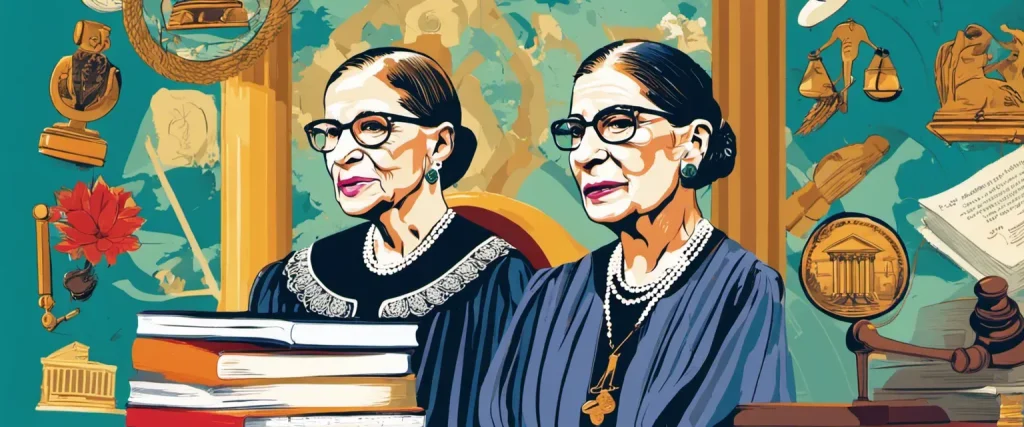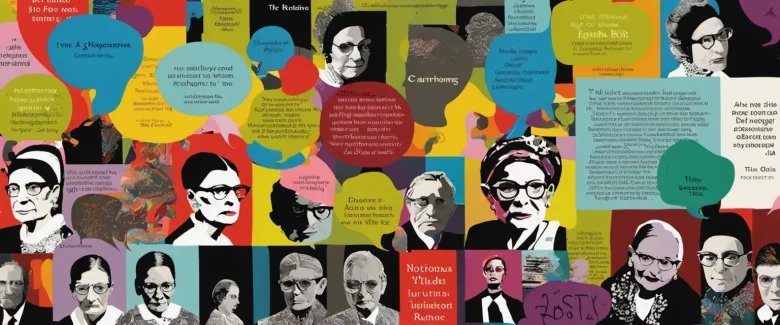In “Notorious RBG,” Irin Carmon skillfully reveals the extraordinary life and profound impact of one of the most influential women in American history, Justice Ruth Bader Ginsburg. Carmon, an acclaimed journalist known for her expertise in covering gender, politics, and law, sheds light on the remarkable journey of this iconic figure who fought tirelessly for gender equality and justice throughout her illustrious career. Through thorough research and exclusive interviews, Carmon paints an intimate portrait of Justice Ginsburg, highlighting her early struggles, pioneering legal work, and enduring legacy as a beacon of hope for generations to come.
Chapter 1: Introduction to Ruth Bader Ginsburg
Chapter 1: Introduction to Ruth Bader Ginsburg of the book Notorious RBG by Irin Carmon provides a captivating overview of the life and career of Supreme Court Justice Ruth Bader Ginsburg.
The chapter begins by highlighting the significance and influence of Ruth Bader Ginsburg, often referred to as the “Notorious RBG,” on American society and women’s rights. It introduces Ginsburg as a trailblazing figure who has dedicated her life to fighting for gender equality and social justice.
Carmon delves into Ginsburg’s early experiences, chronicling her upbringing in Brooklyn, New York, and her formative years at Cornell University. The author emphasizes how Ginsburg’s parents and their struggles as Jewish immigrants shaped her societal perspective and inspired her commitment to fight against injustice.
Moving forward, Carmon explores Ginsburg’s journey as a student at Harvard Law School, where she faced discrimination as one of the few female law students. This discrimination fueled Ginsburg’s determination to challenge the gender bias prevalent within the legal profession, a mission she would carry throughout her career.
The chapter also underscores Ginsburg’s pivotal role in cofounding the Women’s Rights Project at the American Civil Liberties Union (ACLU), a platform that allowed her to successfully advocate for equal rights before the Supreme Court. It highlights key cases Ginsburg argued, such as Reed v. Reed, and how she strategically used the courts to challenge discriminatory laws.
In conclusion, Chapter 1 sets the stage for the remarkable life and achievements of Ruth Bader Ginsburg. It effectively introduces Ginsburg’s strong foundation, early experiences, and her unwavering commitment to fighting for gender equality and social justice. Carmon’s captivating writing style creates intrigue and admiration for the impactful life and legacy of the Notorious RBG.
Chapter 2: Early Life and Education
Chapter 2 of “Notorious RBG” by Irin Carmon explores the early life and education of Ruth Bader Ginsburg, tracing the formative experiences that shaped her into the influential Supreme Court Justice she would become.
The chapter begins by delving into Ginsburg’s upbringing in a working-class Jewish neighborhood in Brooklyn, New York. Born in 1933, she grew up during a time when gender roles were deeply ingrained in society. Her mother, Celia Bader, played a significant role in shaping Ruth’s character, teaching her the value of education and hard work.
Ginsburg’s mother passed away from cancer just days before Ruth graduated from high school, which had a profound impact on her and underscored her determination to achieve her goals. Ruth recognized the practicality of education and excelled academically, attending Cornell University on a scholarship.
Despite facing discrimination as one of the few female students at Cornell, Ginsburg persevered and graduated at the top of her class. She then pursued law studies at Harvard University, even though she was one of only nine women in a class of over 500. Ruth managed to balance her academic excellence with her role as a wife and mother to her first child, Jane.
After her husband, Marty, accepted a job in New York, Ruth transferred to Columbia Law School, where she continued to excel. Throughout her time in law school, Ginsburg faced numerous instances of gender discrimination, which fueled her tenacity to fight for gender equality later in her career.
In conclusion, Chapter 2 of “Notorious RBG” provides an in-depth look into Ruth Bader Ginsburg’s early life and her journey through education, illustrating how her upbringing and experiences formed the foundation for her relentless pursuit of justice and equality.
Chapter 3: Law Career and Activism
Chapter 3 of “Notorious RBG” focuses on Ruth Bader Ginsburg’s early career as a law professor, her involvement in landmark gender equality cases, and her commitment to activism.
The chapter begins by exploring Ginsburg’s transition from academia to activism in the late 1960s. As a law professor at Rutgers University, she became deeply involved in the women’s rights movement and co-founded the Women’s Rights Law Reporter, the first law journal devoted to gender issues. Ginsburg believed in challenging discriminatory laws that perpetuated gender inequality and she saw the law as a tool for achieving social change.
The chapter highlights Ginsburg’s involvement in several pivotal cases that played a crucial role in advancing gender equality. One prominent example is the Reed v. Reed case, where she successfully argued before the Supreme Court that laws that discriminate on the basis of sex violate the Equal Protection Clause of the Fourteenth Amendment. This victory marked the first time the Supreme Court struck down a law on the grounds of gender discrimination.
Throughout her career, Ginsburg consistently advocated for equal rights for women, but she also recognized the importance of advancing other causes addressing different forms of discrimination. She supported the LGBTQ+ movement, advocating for LGBTQ+ rights and arguing against discrimination based on sexual orientation.
Additionally, the chapter highlights Ginsburg’s influential work as a Supreme Court justice, especially her notable opinions and dissents. Even when she was in the minority, her dissents became known for their eloquence and powerful force, earning her the “Notorious RBG” moniker as a symbol of her fearless advocacy.
Overall, Chapter 3 portrays Ruth Bader Ginsburg as an influential figure in the fight for gender equality, highlighting her career as a law professor, her landmark cases, and her activism beyond gender issues.
Chapter 4: Supreme Court Appointment

Chapter 4 of “Notorious RBG” by Irin Carmon is titled “Supreme Court Appointment.” This chapter focuses on Ruth Bader Ginsburg’s landmark appointment to the United States Supreme Court in 1993. The chapter explores the circumstances leading to her nomination and the subsequent confirmation process.
The chapter begins by discussing Justice Byron White’s retirement announcement and the subsequent deliberations within the Clinton administration on selecting a suitable replacement. President Bill Clinton ultimately chose Ginsburg, then a judge on the D.C. Circuit Court of Appeals. Carmon highlights Ginsburg’s impressive legal career, her deep knowledge of constitutional law, and her commitment to gender equality as key factors in her nomination.
The chapter then delves into the confirmation process, which faced significant challenges. On one hand, Ginsburg’s confirmation was seen as groundbreaking for being only the second woman appointed to the Supreme Court. However, her liberal views raised concerns among conservatives and led to tough questioning during the Senate Judiciary Committee hearings.
Carmon provides a detailed account of Ginsburg’s testimony during the confirmation hearings, where she skillfully avoided making firm commitments on specific issues while presenting herself as a moderate judge. Ginsburg’s deft answers and her exceptional legal understanding won over many skeptics, and despite tough questioning, she was eventually confirmed by the Senate with an impressive majority vote.
Throughout the chapter, Carmon constantly highlights Ginsburg’s role as a trailblazer for women, noting how her appointment marked a significant step forward for gender equality on the Supreme Court. The chapter concludes by emphasizing Ginsburg’s dedication to her work and her commitment to championing equal rights and justice for all.
In summary, Chapter 4 of “Notorious RBG” focuses on Ruth Bader Ginsburg’s historic appointment to the Supreme Court and the confirmation process she underwent. Carmon highlights Ginsburg’s legal experience and commitment to gender equality, explores the challenges she faced during the hearings, and concludes by emphasizing the lasting impact of her appointment on the Supreme Court.
Chapter 5: Landmark Cases and Judicial Philosophy
Chapter 5 of “Notorious RBG” focuses on the landmark cases and judicial philosophy of Supreme Court Justice Ruth Bader Ginsburg. The chapter, titled “L3: Loving, Liberty, Lawsuits, and Dissents,” delves into significant cases that have shaped Ginsburg’s views and have helped her become an influential figure in the realm of gender equality and civil rights.
The chapter starts with Ginsburg’s admiration for the Loving v. Virginia case, which invalidated laws prohibiting interracial marriage. This case established a foundation for Ginsburg’s belief in equal protection under the law and became the basis for her later work in promoting gender equality.
Carmon then highlights Ginsburg’s dissents in various cases to shed light on her judicial philosophy. These dissents reveal her commitment to upholding civil rights and her desire for progress in areas such as voting rights, affirmative action, and gender discrimination.
The chapter also explores Ginsburg’s involvement in strategic legal activism before joining the Supreme Court. Her work as a lawyer and advocate prepared her for the significant role she would play in shaping the Court’s opinions on gender and civil rights issues.
Throughout the chapter, Carmon showcases Ginsburg’s approach to jurisprudence, emphasizing her belief in incremental change and the importance of dissenting opinions. Ginsburg’s opinions and dissents have left a powerful impact on the law, and her dedication to championing gender equality and civil rights continues to inspire many.
Overall, Chapter 5 of “Notorious RBG” delves into the key cases and judicial philosophy that have shaped Justice Ruth Bader Ginsburg’s career and solidified her status as an influential figure in the fight for equality and justice.
Chapter 6: Personal Life and Influence
Chapter 6 of the book “Notorious RBG: The Life and Times of Ruth Bader Ginsburg” by Irin Carmon explores the personal life and influence of Ruth Bader Ginsburg. This chapter delves into Ginsburg’s upbringing, relationships, and her influential role as a Supreme Court Justice.
The chapter begins with an examination of Ginsburg’s childhood and the impact of her parents on her development. Ginsburg’s mother, Celia, greatly influenced her daughter’s strong work ethic and independence, while her father, Nathan, encouraged her to pursue education and fight against gender discrimination. These ideals would shape Ginsburg’s future path as a fierce advocate for gender equality.
Carmon also explores Ginsburg’s personal relationships, particularly highlighting her deep connection with her husband, Marty. Their marriage was characterized by mutual respect and support, and Marty played a crucial role in Ginsburg’s career success. His unwavering belief in her abilities allowed Ginsburg to pursue her ambitions without any fear of personal sacrifices.
Furthermore, Carmon details Ginsburg’s profound impact as a Supreme Court Justice. Ginsburg consistently championed the rights of minoritized groups and worked tirelessly to ensure gender equality under the law. She was instrumental in landmark cases, such as United States v. Virginia, which resulted in the dismantling of gender barriers within the Virginia Military Institute. Ginsburg’s opinions and dissents showcased her sharp intellect, legal expertise, and dedication to creating a more equitable society.
Overall, Chapter 6 provides a comprehensive overview of Ruth Bader Ginsburg’s personal life and the significant influence she had both on a personal level and as a trailblazer within the legal system. It sheds light on the formative experiences and relationships that shaped her, allowing readers to gain a deeper understanding of the woman behind the notorious RBG legacy.
Chapter 7: RBG’s Dissenting Opinions
Chapter 7 of “Notorious RBG” by Irin Carmon explores several of Justice Ruth Bader Ginsburg’s notable dissenting opinions during her time on the Supreme Court. Ginsburg, known for her fierce determination and commitment to gender equality, used her dissents as a platform to voice her strong beliefs and advocate for marginalized groups.
The chapter begins by discussing Ginsburg’s dissent in the Ledbetter v. Goodyear Tire & Rubber Co. case, where she argued for equal pay for women. Despite the Court’s majority ruling against Lilly Ledbetter, Ginsburg’s dissent gained widespread attention and eventually led to the enactment of the Lilly Ledbetter Fair Pay Act, which extended the statute of limitations for filing pay discrimination claims.
The chapter also delves into Ginsburg’s impassioned dissent in the Hobby Lobby case, where the Court allowed corporations to claim religious exemptions from providing certain forms of contraception to employees. Ginsburg argued that this decision undermined women’s rights and set a dangerous precedent, highlighting her fight for reproductive freedom.
Furthermore, Ginsburg’s dissent in the Shelby County v. Holder case is explored, where she opposed the majority’s decision to strike down a key provision of the Voting Rights Act. She expressed concerns that this would lead to a rise in discriminatory voting practices and harm minority communities.
By examining these dissenting opinions and their impact, the chapter showcases Ginsburg’s determination to use her role on the Court to champion gender equality, civil rights, and social justice. It portrays her as a powerful voice for marginalized communities and highlights the enduring influence of her dissenting opinions on American law and society.

Chapter 8: Legacy and Lasting Impact
In Chapter 8 of “Notorious RBG” by Irin Carmon, titled “Legacy and Lasting Impact,” the author delves into the profound impact and enduring legacy of Ruth Bader Ginsburg, both as a Supreme Court Justice and as a cultural icon.
Carmon begins by emphasizing Justice Ginsburg’s exceptional mind and unparalleled work ethic, highlighting her ability to formulate groundbreaking legal arguments that challenged gender discrimination in the American legal system. Ginsburg’s influence on women’s rights was particularly significant, as she played a pivotal role in shaping landmark decisions that granted women equal rights and protection under the law.
Additionally, Carmon explores how Ginsburg’s fearless dissenting opinions ensured that her voice would be heard even in the face of legal setbacks. These dissents ultimately positioned her as the beacon of hope for progressive ideals and garnered her the nickname “Notorious RBG,” symbolizing her determination and resilience.
The chapter also emphasizes how Ginsburg contributed to the shifting societal perception of feminist issues. She managed to bridge the divide between being a legal scholar and a pop culture icon, capturing the attention and admiration of younger generations who saw her as a symbol of empowerment and advocacy for justice.
Furthermore, Carmon explores Ginsburg’s lasting impact on the Supreme Court itself. Ginsburg’s work helped solidify the importance of representation on the bench, urging the inclusion of diverse perspectives and backgrounds when making crucial legal decisions. Her legacy also extends to the “RBG Bench” phenomenon, wherein law students and attorneys across the country seek to emulate her approach to justice, highlighting the enduring nature of her influence.
Ultimately, Chapter 8 of “Notorious RBG” illustrates how Ruth Bader Ginsburg’s extraordinary career and unwavering dedication to fighting for equality have left an indelible mark on American society, shaping the way we perceive and pursue justice.
After Reading
In conclusion, “Notorious RBG” by Irin Carmon offers an insightful and inspiring look into the life and legacy of Ruth Bader Ginsburg. Through a clever blend of biography, interview excerpts, and personal anecdotes, Carmon highlights Ginsburg’s remarkable journey as a groundbreaking Supreme Court Justice, feminist icon, and cultural phenomenon. The book showcases RBG’s unwavering commitment to gender equality, civil rights, and justice, while also delving into her personal experiences and unwavering work ethic. Ultimately, “Notorious RBG” serves as an homage to Ginsburg’s exceptional career and the indelible impact she made on American law and society.
1. And Then There Were None” by Agatha Christie – If you enjoyed “Agatha Christie” by Agatha Christie, then you definitely shouldn’t miss her classic mystery masterpiece, “And Then There Were None.” This gripping and cleverly plotted novel will keep you guessing until the very end.
2. Becoming” by Michelle Obama – For fans of “Becoming” by Michelle Obama, I would recommend “Educated” by Tara Westover. This memoir tells the inspiring story of a woman who grows up in a strict and dysfunctional household in rural Idaho but manages to break free and pursue an education against all odds.
3. Know My Name” by Chanel Miller – After delving into “Know My Name” by Chanel Miller, you might be interested in “We Should All Be Feminists” by Chimamanda Ngozi Adichie. In this powerful essay, Adichie explores the importance of feminism in today’s world and urges readers to strive for gender equality.
4. “The Secret History” by Donna Tartt – If you enjoyed “Agatha Christie” by Agatha Christie, you might find “The Secret History” by Donna Tartt intriguing. This compelling novel delves into the dark secrets of a group of eccentric classics students at an elite New England college and explores themes of guilt, obsession, and the consequences of one’s actions.
5. The Immortal Life of Henrietta Lacks” by Rebecca Skloot – Inspired by the thought-provoking nature of “Becoming” by Michelle Obama, “The Immortal Life of Henrietta Lacks” by Rebecca Skloot is a captivating work of non-fiction. Skloot explores the incredible story of a woman named Henrietta Lacks, whose cells were used without her knowledge to make groundbreaking scientific discoveries and revolutionize medical research. This book raises important questions about ethics, race, and the intersection of science and human rights.



